What to see in Cáceres - Quick tourism guide
The monumental ensemble of the city of Cáceres is simply impressive. In the Old Town (the historic center), you can see numerous palaces, towers, churches, and museums.
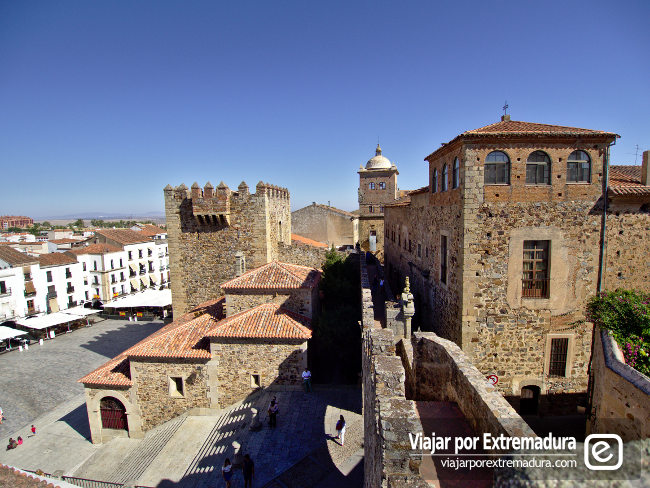
Plan your visit to Cáceres
When is the best time to visit Cáceres?
Any time of the year.
Keep in mind that during the hottest summer months, it can get quite hot, and it’s advisable to visit the monuments early in the morning.
How much time will we need to visit Cáceres?
Most of the monuments in Cáceres are concentrated in the historic center (intramuros), so there’s no time wasted on travel.
I think you can have a relatively relaxed visit in a couple of days.
Proposed itinerary for visiting Cáceres
Let’s propose an itinerary that I really like.
In this route, we won’t separate by stages. You can simply organize yourself over several days or change it on the go according to your preferences.
The reference map for the route is this:
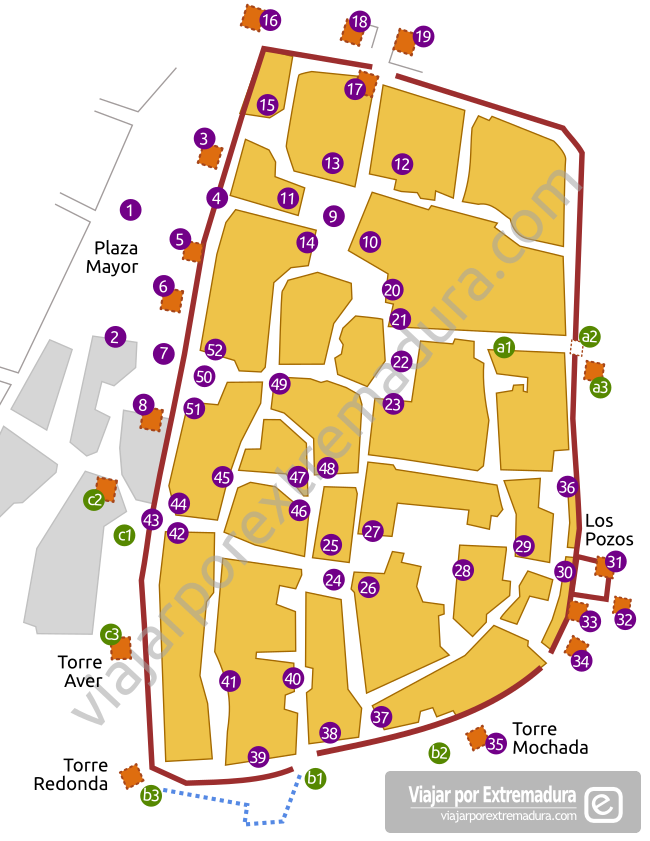
Guide map for the tourist route through Cáceres
The numbers mark the sequence we will follow and are associated with a monument (we will indicate the number in parentheses next to the name of the monument). In some cases, alternative routes are suggested using letters (a1, a2, … c1, c2…).
The Plaza Mayor (1)
It is the heart of the city of Cáceres and the point we will take as a reference to start the visit.
In the Plaza Mayor is the building of the City Hall of Cáceres (2), and there are numerous restaurants and cafes.
From the square itself, we can see some of the enormous defensive towers of the wall, among which the Torre de Bujaco stands out.
Before entering the Old Town, we will take a short walk through the square, approaching some of these towers.
Torre de Bujaco (3)
The Torre de Bujaco is part of the city’s history.
It was rebuilt by the Almohads in the 12th century. It is an albarrana tower (separated from the main wall).
Next to the tower, the Ermita de la Paz was built in the 18th century.
The tower can be visited, and you can climb to its battlements, from where you will have incredible views of the city.
Arco de la Estrella (4)
This gateway to the Old Town was built in the 15th century to facilitate transit to the square. Its current shape corresponds to a remodeling done in the 18th century.
Torre de los Púlpitos (5)
It is one of the few towers built by the Christian army after the definitive conquest of Cáceres.
The outer corners are topped with cylindrical embrasures that resemble the old pulpits of churches, hence its name.
Torre de la Yerba (Torre de la Hierba) (6)
It is an albarrana tower that was part of the Muslim defenses; its construction is dated to the 12th century.
Foro de los Balbos (Atrio del Corregidor) (7)
At this point was one of the gates of access to the Roman city, Norba Caesarina.
Currently, this space forms a small square where the pillar of San Francisco, in Plateresque style, is located.
And on one side, we can see a replica of what is known as the goddess Ceres (possibly the statue actually represents a genius of the Roman colony).
Visit the Tower of Bujaco and the battlements
It is worth entering the Tower of Bujaco and going up to its battlements.
Inside, there is an interpretation center where you will be given information about the tower itself and recommendations for visiting the historic center.

The views from the battlements of the Tower of Bujaco are impressive, both of the modern part of the city and the buildings of the old town.
In addition, we can walk along a stretch of the adarve, on the walls, passing through the upper part of the Arco de la Estrella (4) and reaching the battlements of the Torre de los Púlpitos (5).
It’s a whole experience.
Plaza de Santa María (9)
We now enter the intramuros area of the Old Town.
Plaza de Santa María is a pedestrian space where you will find some of the best-known buildings in Cáceres: the Concathedral of Santa María, the Carvajal Palace, the Episcopal Palace, the Casa de Hernando de Ovando, the Mayoralgo Palace, or the Provincial Diputación Palace.
Concathedral of Santa María (10)
It is the most important Christian temple in Cáceres.
It was built between the 15th and 16th centuries on a building (a small Romanesque church) from the 13th century.
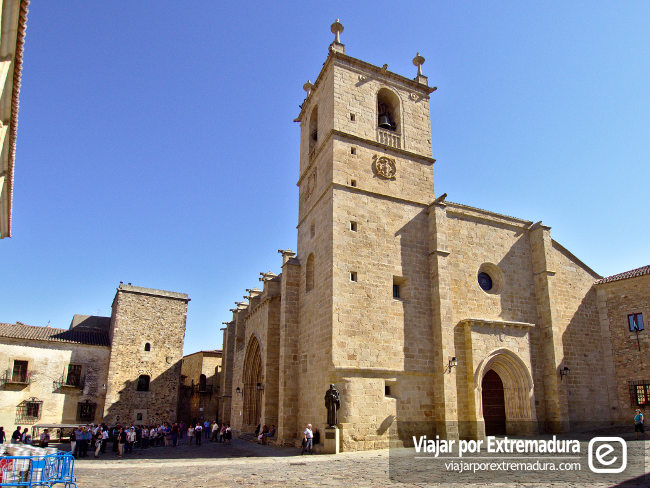
In the corner facing the square is the statue of San Pedro de Alcántara (by Pérez Comendador).
Inside the concathedral is the carving of the Black Christ, from the mid-14th century.
Episcopal Palace (11)
Located next to Calle del Arco (near the Arco de la Estrella). It has a very beautiful Renaissance-style facade.
Carvajal Palace (12)
With a very beautiful granite facade, the Carvajal Palace was built between the 14th and 15th centuries, preserving some older elements (e.g., the Round Tower).
The Carvajal Palace can be visited: access to the cloister and the Renaissance garden is allowed.
Hernando Ovando Palace (13)
It is known as the Ovando’s Palace.
It is a Renaissance building from the 16th century, with some later reforms from the 18th century.
Also from the early 16th century, although it was later renovated in the 18th century. The tower is part of an earlier 15th-century building. Its Renaissance facade highlights the round arch and the coat of arms.
Mayoralgo Palace (14)
Built between the 14th and 15th centuries, but the facade is later, from the 16th century.
The facade is very sober and includes Gothic elements.
Toledo-Moctezuma Palace (15)
It is located in the northwest corner of the walled enclosure.
The masonry and brick tower of the palace, with its characteristic dome, we had already seen from the top of the Tower of Bujaco and the adarve.
We can see the facade of the Palace of Toledo Moctezuma by accessing the Plaza del Conde de Canilleros (from the Plaza de Santa María or from the Arco de la Estrella).
Several towers were part of the Arab defensive perimeter:
- Buraca Tower or Tower of Garbage (16) - Albarrana.
- Tower of El Socorro (19). It is integrated into the stone building that corners the Plaza del Conde de Canilleros.
- Tower of El Cristo (20) - It is located in the surroundings of the Casa del Sol, and it is the only one with a horseshoe arch window.
Palace of the Provincial Deputation (20)
The Palace of the Provincial Deputation is a 15th-century building that has undergone numerous reforms.
Golfines de Abajo Palace (21)
It is one of the most beautiful palaces in Cáceres.
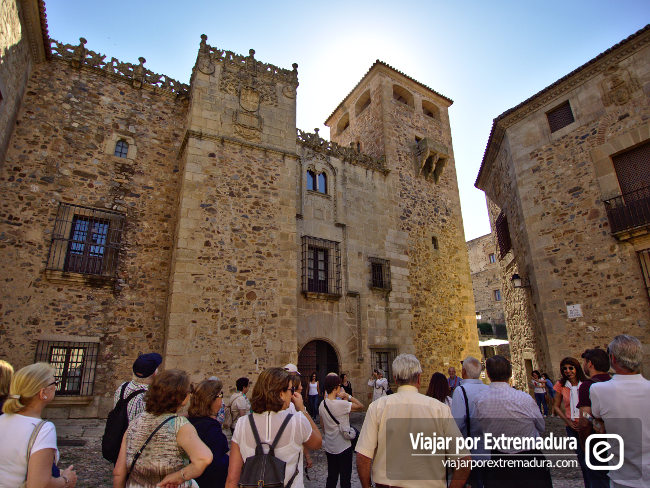
On one side, it follows a Gothic style, as seen in the corner tower (15th century).
But perhaps what stands out the most is its Plateresque facade from the 16th century.
St. George Square (22)
It is another charming and photogenic place in Cáceres.
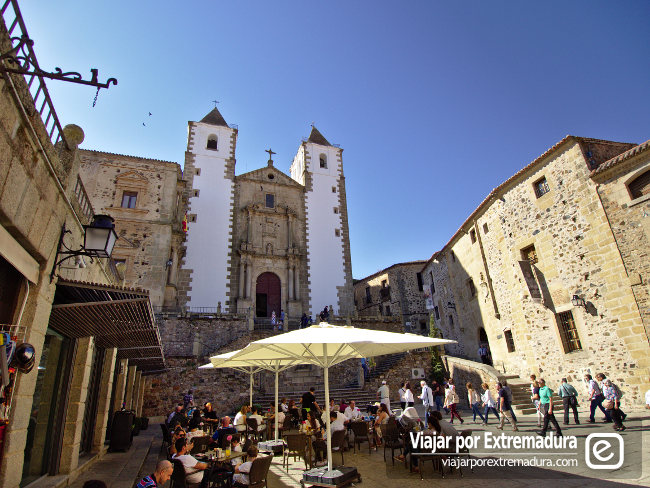
The first thing one sees is the impressive facade of the San Francisco Javier church.
The square is dedicated to St. George, the patron saint of Cáceres, and next to the stairs leading to the church, we can see the bronze statue of St. George and the dragon.
In the square, we can see the Casa de los Becerra, a Gothic building from the mid-15th century.
San Francisco Javier Church (23)
It is a Jesuit church built in the 18th century.
The San Francisco Javier Church is in Baroque style, with a single nave.
What stands out from the outside are the two lateral towers topped with pyramid-shaped roofs.
Arch of Christ / Jewish Quarter
This is an alternative route that we can take before going up to the high area.
From St. George Square, we can follow Cuesta del Marqués downhill, and we will come across the Yusuf Al-Burch Arab House Museum (a1), which is worth visiting as it gives us a glimpse of life in a Muslim house in Cáceres in the 12th century.
A little further down, we find the Arch of Christ (a2), also known as Puerta del Río.
It is the oldest preserved gate in the Cáceres wall and is built with ashlars from the ancient Roman wall.
The gate was defended by two large towers, of which only the Tower of the River (a3) remains, which we can see just after crossing the Arch of Christ.
Although we could go to the high area through the narrow streets of the Jewish Quarter, we are going to return to St. George Square to go up Cuesta de la Compañía towards St. Mateo Square.
Upper Quarter / St. Mateo Square (24)
It is part of what is known as the Upper Quarter, the highest part of the hill, where the Almohad fortress was located.
In the Upper Quarter, we find several squares, which actually form a single open space:
- St. Mateo Square
- St. Paul Square
- Veletas Square
St. Mateo Church
St. Mateo Church was built on a site previously occupied by a mosque and later by a small Christian temple.
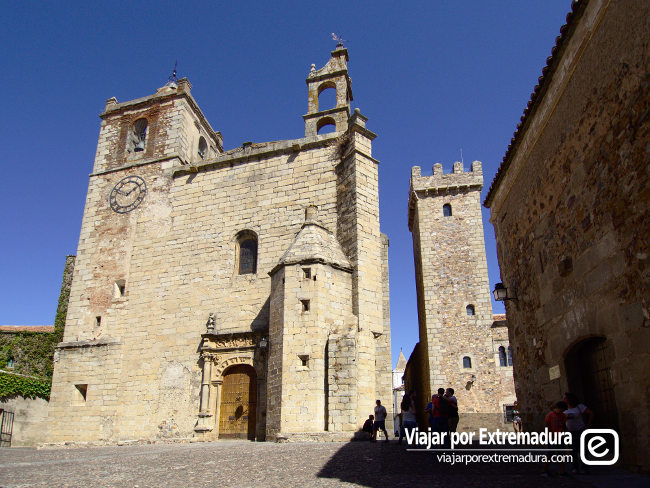
Construction began in the 16th century.
The main body is in Gothic style, but the tower was built in the late 18th century, and the portal is Plateresque.
San Pablo Convent (26)
It is a 15th-century Gothic building. The bell tower’s belfry was added in the 18th century.
Currently, it is a cloistered convent of the Clarisse nuns (Order of St. Clare).
Storks’ Palace (27)
Actually, it is the Palace of the Cáceres Ovando, but the tower is very peculiar and is known as the Storks’ Tower, and finally, the palace itself took on the popular name of Storks’ Palace.
The building was constructed in the late 15th century.
The Storks’ Tower is the only one that was not truncated by order of Isabella the Catholic (1477), as it was under construction, and its owner, Captain Diego de Ovando, was a member of the Queen’s Council and had her trust.
On the ground floor is the Arms Museum, which usually opens on weekends.
Veletas Palace (Cáceres Museum) (28)
The building of the Veletas Palace is currently the headquarters of the Museum of Cáceres, one of the must-visit places in the city.
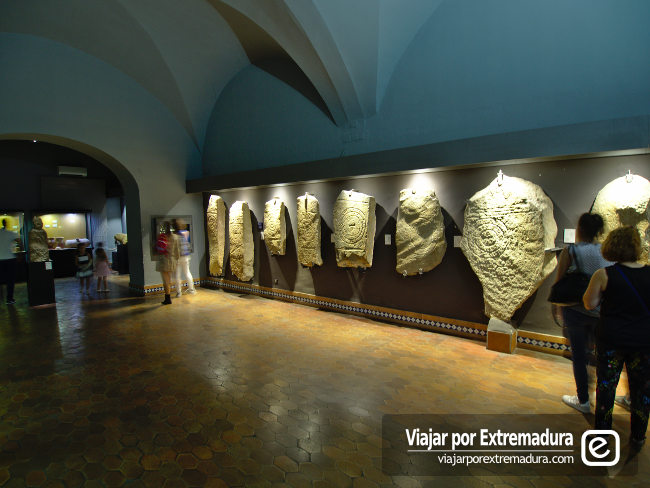
Although it does not have defensive elements (towers, machicolations…), the Veletas Palace was built as a fortress house in the 15th century. Numerous reforms were made throughout the 16th century.
The decorative elements of the upper part (balustrade) are from the 18th century.
In some of these elements, weather vanes were placed, which ended up giving the palace its name.
Museum of Cáceres
In the museum, we find an important archaeological and ethnographic collection.
Through a tour of different rooms, elements from the Paleolithic to the Roman period are presented.
The ethnographic collection includes elements of everyday life in Cáceres and its province.
The Fine Arts collection is housed in a building next to the palace, known as the Casa de los Caballos (29).
Cistern (aljibe) of the Veletas Palace
It is another great attraction of the visit to the Museum of Cáceres.
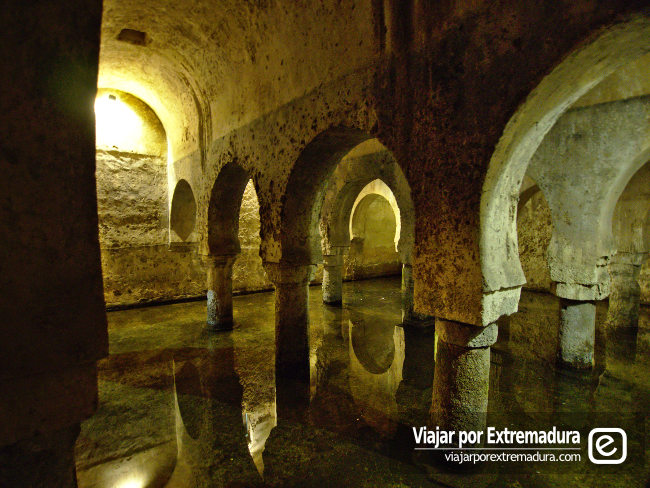
It is one of the largest and best-preserved cisterns in the Peninsula.
It was part of the Almohad fortress dating back to at least the 12th century and is still in use today.
More information about the Cistern of the Veletas Palace in Cáceres.
Baluarte de los Pozos (30)
About 15 meters from the rear facade of the Casa de los Caballos, we find the Interpretation Center of the Baluarte de los Pozos.
The Baluarte de los Pozos is a defensive bulge of the wall that protected a water reservoir known as the Cistern of San Roque (located at the level of what is now the road).
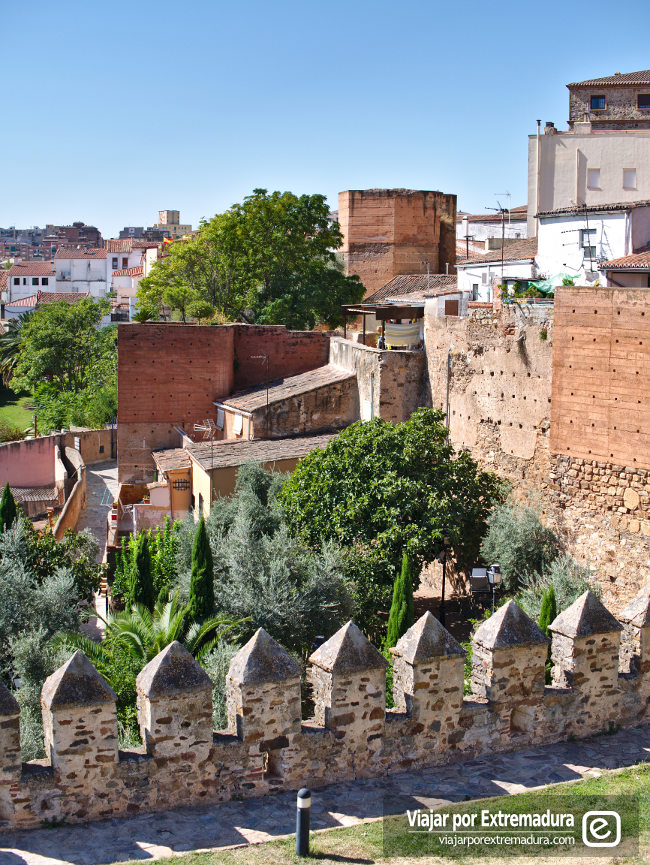
It also defended the exit from the city towards the Ribera del Marco, where the resources that supplied water to the city were located.
The bulwark had two large towers:
- The Tower of the Wells (31)
- The Tower of the Cisterns (32)
Further down, outside the wall, are the remains of what is known as the Coracha Tower.
And next to the bulwark, in the layout of the main wall, is the Attached Tower (33), also known as the Olive Grove Cube.
And a little further along, following the wall’s layout, we can see the Albarrana Tower (Tower of Hernando Pizarro Street) (34) and the one known as Mochada Tower (or Desmochada Tower) (35) with its characteristic octagonal plan.
The views from the top of the Baluarte de los Pozos are incredible.
Olivar de la Judería (33)
It is a small, beautiful landscaped park located next to the base of the Baluarte de los Pozos, right where the Attached Tower is.
To get there, we have to take a downhill street located a few meters from the interpretation center.
Old Jewish Quarter (Jewish Quarter)
All this area of the Baluarte de los Pozos, the Olivar de la Judería, and the streets that descend towards the Arch of Christ (a2) are part of what is known as the Old Jewish Quarter or Old Jewish Quarter of Cáceres.
We have already visited some of its streets (e.g., Cuesta del Marqués).
We would still need to see, for example, the Hermitage of San Antonio (36), which was previously the Synagogue of the Jewish Quarter.
To reach the Hermitage of San Antonio, we have to go down from the interpretation center of the bulwark through Barrio de San Antonio Street.
Mérida Gate Area (38)
We now head towards the south wall, where the Mérida Gate was located, now disappeared.
This gate initially formed part of the Roman wall and was rebuilt by the Arabs. It was probably very similar to the Arch of Christ. It disappeared in the mid-18th century.
To reach this area, we can use the House of the Horses (29) as a reference and follow Pereros Street to Pereros Square.
We can also go down San Pablo Street from St. Mateo Square (24).
In Pereros Square is the House Palace of the Pereros (37), a fortress house from the 15th - 16th centuries.
We continue along Puerta de Mérida Street and find the House of the Sánchez-Paredes (38), known as Delgadillo House, from the 15th century.
Right in front would be the Mérida Gate.
Santa Clara Square
Let’s take the opportunity to visit Santa Clara Square (b1), which is located outside the wall.
And we will use it as a reference to approach the Mochada Tower (35) and the Round Tower (b3), two octagonal-shaped towers.
We had already seen the Mochada Tower from the Bulwark of the Wells.
To see it up close, we just have to follow Torremochada Street a few meters.
We can only see the top of the Round Tower. From Santa Clara Square, we have to follow Cornudilla Street almost to the corner that leads to Hornos Street.
Western area of the intramural enclosure
We return to the Upper Quarter, but this time following the layout of the west wall (which will be on our left)
We will come across various buildings:
- The Hospital of the Knights (39)
- Palace of the Marquises of Torreorgaz (40)
- Also known as the Comendador de Alcuéscar Palace.
- The House of Ovando Perero (41)
- And next to the wall, a little higher up, we find the Palace of the Golfines de Arriba.
Golfines de Arriba Palace (42)
This fortress house belonged to one of the branches of the Golfín family.
It was built throughout the 14th and 15th centuries, although only three of the four towers are preserved.
The keep is located in the central part of the house.
Next to one of the palace’s towers, in the wall section, we see the Santa Ana Arch (43).
And in that same square is the Palace of the Counts of Adanero (43)
The Mudéjar House (45)
Taking the Palace of the Golfines de Arriba as a reference, if we go down Cuesta de Aldana Street, we will come across the Mudéjar House, from the 14th century.
The upper part of the house is built in brick, with horseshoe arches.
The Tower of Sande (46)
It is another of the iconic elements of the city, which we will have seen many times in photos of Cáceres.
The tower is part of the Paredes-Saavedra House, from the 14th and 15th centuries.
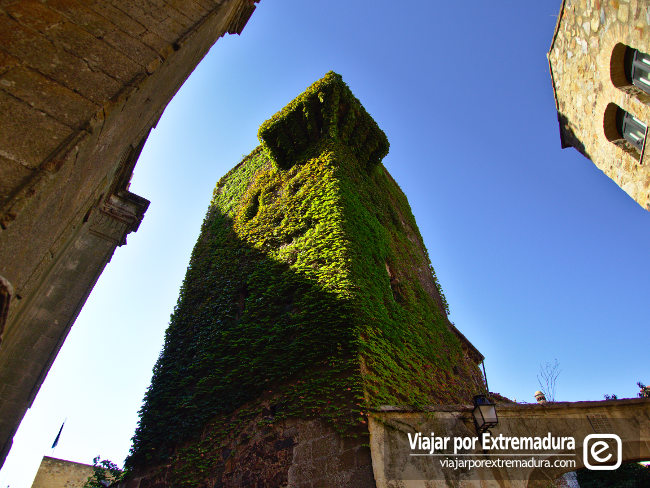
What stands out above all is the enormous corner machicolation, and also the walls are usually covered with ivy, giving it that characteristic look.
In the surroundings, we also have several historic buildings:
- The Eagle House (47) Also known as the Mansion of the Sande.
- The House of the Sun (House of the Solís) (48)
- The Monkey House (House of the Pizarro-Espadero) (49)
Caldereros Square (50)
If we follow Calle del Mono westward, towards the wall, we reach Caldereros Square (or Caldereros Square).
In this square, we find several interesting things:
- The Generala Palace (51) From the late 15th century. It currently forms part of the University of Extremadura.
- Ribera’s House (52)
- The Little Door of Piñuelas Square. An arch in the wall that gives us access to Piñuelas Square, near the Main Square and next to the Balbos Forum (7).
From Piñuelas Square, we have a fantastic view of some of the towers that we had already contemplated from below, from the Main Square: the Tower of the Oven (8) and the Tower of the Herb (6)
Other points of interest in the city of Cáceres
So far, we have only seen the treasure that Cáceres guards in its Old Town.
But there are many more interesting places worth visiting:
- Cánovas Promenade. One of the main arteries of Cáceres. This landscaped area is perfect for a walk.
- The Helga de Alvear Museum of Contemporary Art
- The History and Culture Museum Casa Pedrilla and the Guayasamín Museum
- The interpretation center of the Maltravieso Cave. Where significant remains and paintings from the Upper Paleolithic have been found.
- Roman Camp of Cáceres el Viejo. It is on the road to Torrejón el Rubio (EX-390), and you can visit the Interpretation Center of Cáceres el Viejo, with information about the camp and the life of the soldiers.
- Natural Monument of Los Barruecos. A few kilometers from Cáceres, near Malpartida de Cáceres. A beautiful natural environment.
